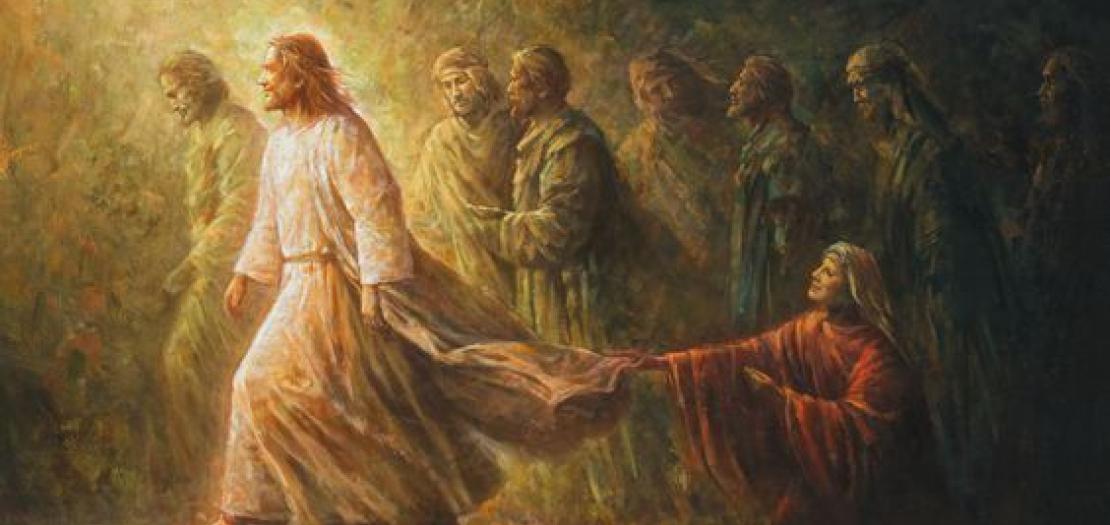Issued by the Catholic Center for Studies and Media - Jordan. Editor-in-chief Fr. Rif'at Bader - موقع أبونا abouna.org

Following is the text of meditation by Cardinal Pierbattista Pizzaballa, Latin Patriarch of Jerusalem: The 13th Sunday of ordinary time, dated June 30, 2024:
A key reading that can help us in understanding today's Gospel passage (Mark 5:21-43) is verse 33: the woman afflicted with hemorrhages, after stealthily being healed by Jesus, is invited to come out, to show herself (Mark 5:30). And she does, but she does so "in fear and trembling." (Mark 5:33)
These are not two random adjectives.
We find them in the Letter to the Hebrews (Hebrews 12:18), in the chapter in which the author reflects on the two covenants, the one stipulated on Sinai (Exodus 19) and the one renewed with the Passover of Jesus.
The author of the Epistle, speaking to his readers, says that they did not approach a tremendous and dramatic event, such as that recounted in the Theophany on Sinai: in that case, the spectacle was so terrifying that even Moses said. " I am terrified and trembling." (Hebrews 12:21)
Moses too, before the Sinai Theophany, is like the hemorrhagic woman before Jesus: both afraid and trembling.
But why was Moses afraid? Certainly, because the theophany was awesome: lightning, thunder, earthquakes, and fire. But not only because of that. There had to be a space, a definite distance between the people and the place of God's presence. There was to be no contamination. Anyone who approached the mount of Theophany, or contaminated the sacred space, was even to be put to death! (Exodus 19:12) Even in the Temple, a clear separation would later be made between the sacred place par excellence, accessible to a few and only at certain times, and the rest of the people.
Then we are faced with two different ways of seeing God: that of Moses, where one cannot approach God. That of the hemorrhaging woman, where there is the opposite: he who touches God lives.
If anything, one can die not from touching him but from not touching him. Indeed, the woman's whole plan, once she heard about Jesus, revolved around the possibility of a touch: “If I but touch his clothes, I shall be cured.” (Mark 5:28)
The woman is trembling, because she is afraid. After all, the woman has an idea of God that is common to so many, a God from whom to snatch salvation, a God who is frightening.
Jesus urges her to come out, not confirming this face of God to her, but overthrowing it, and he does so with words capable of healing the heart: "Daughter, go in peace." (Mark 5:34)
First of all, this is the only time in Mark’s Gospel when Jesus calls someone "daughter". This woman, who dared to touch the God-with-us, has fully found her identity, her truth, that of Daughter of the Father.
This daughter can now go in peace, because the time of fear is over, and the time of trust and love has begun. To touch Jesus, the ultimate presence of God among us, and to be touched by Him, to meet Him, is no longer forbidden. There is no longer a separation between the sacred and the profane.
That this time has commenced. We also see in the other scene recounted in today's passage, and with which the Gospel had begun: a synagogue leader, that is, a man of religion, cannot do anything for his sick daughter, and comes to Jesus. As we have seen, Jesus immediately sets out but gets interrupted by the woman afflicted with hemorrhages. And by the time he arrives at Jairus' house, there is nothing to be done: the child is dead. (Mark 5:35)
At that very moment, when all hope seems to disappear, the union between God and humanity is celebrated.
The child is 12 years old, which is the traditional age of marriage. And Jesus brings everyone out of the room, except the father, mother, and those who were with Him, and enters the room where the little girl is.
This room of death becomes a wedding room: Jesus takes her by the hand, (Mark 5:41) as a bridegroom takes his bride by the hand; and the parents hand the bride over to the bridegroom, in front of the witnesses.
The union is complete.
The Word, today, opens the door to a new time for us: a time in which we let go of all our feelings of unworthiness, all our fears, and all our unconscious mechanisms that lead us to think we have to earn salvation by our own efforts, to believe that, in Jesus, the relationship with God is freely given to us and it is only a matter of opening our hearts to Him more and more, of bringing our every desire for salvation and life to Him.
+Pierbattista







